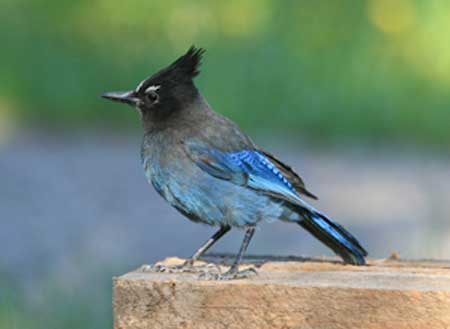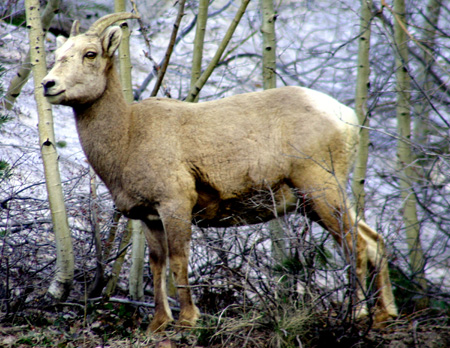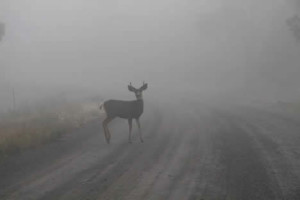Wildlife Viewing in Pagosa Springs Colorado

 Great Opportunities to catch wildlife in the Fall!
Great Opportunities to catch wildlife in the Fall!
Most people think in terms of seeing deer, elk and bear and the larger animals when in the San Juan area, but it is educational to consider the wildlife under the ground. Without the mostly tiny life in the soil none of the more commonly thought of animals could exist.
As you walk deeper and higher into the forest the ground becomes soft and spongy, you are walking on this wildlife! In a deep and old forest this layer of living soil can be several feet thick. It contains life from worm and bug size down to microscopic all working within a natural system turning the death of flora and fauna into food and energy for the next generation. As you walk stop and take a few moments and move back the top ground cover not yet rotted and look into a universe that feeds on itself and up to the tallest trees. It is also interesting to look under moss growing on stones. Life along rivers and streams can also be observed. A pair of polarized sunglasses or a polarized camera filter removed reflections for water and can help give a clear view into streams where fish and a variety of things live.
Seeing the larger wildlife in the forest is not easy! There is a huge population of these animals in the forest and you can be assured they are seeing you! Come back in October and ask any of the hunters lining the forest access roads and they will tell you how difficult it can be; the animals are there but they don’t like the look or smell of you and me, and they try their best to stay at a distance. Fortunately for them the sheer number of hunters is an obvious “presence” in the woods and the animals move back into the deepest, darkest valleys. During the summer hiking months they are more relaxed but still, during the average day hike, you may or may not make sightings.
You can increase your chances by knowing a few things. Deer and elk are nocturnal when the moon is bright and they are likely to rest during the day during this time of the month. When the moon is bright driving forest access roads slowly may allow sightings. Watch for “sparkles of light” when your headlights reflect in the animals eyes.
Both deer and elk like to come out of the forest and warm in the morning sunshine. If you’re able, pick out a likely southeast facing slope with forest at least partially surrounding an open meadow and be there and still before it gets light. Stay at the edge and hide behind brush or anything natural.
If you’re hiking it helps to be quiet as you move along, the animals can hear better than you and commonly stay just out of sight. As you come to each open space, slow down and move over to the trees beside the trail, creep along and look carefully.
Pay attention to your peripheral vision and slowly look left and right as you walk when it’s safe to do so. Many sightings of wildlife are missed when they in plain view because they are camouflaged and remain still when surprised by a hiker. As you pass by they relax and an ear twitch or movement will catch your eye. Try your best not to stop and grab the camera. Keep moving and react and turn slowly as any abrupt movement on your part will likely send the animals scampering away.
The best opportunity to increase seeing wildlife in the forest is to go to the Rocky Mountain Wildlife Park just before you go into the woods. It is located five miles south of Pagosa on Hwy 84. There you can observe most of the animals of this area and have the chance to see how they look in a fairly natural setting. Notice how they move paying close attention to their heads, antlers, tails and ears.
The most common mountain deer, mule deer, have a brownish to a dark gray/silver coat with a lighter belly and rump. They usually have light nose fur with a black tip. There are many dainty and smallish does out there but a mature buck can be big and remind you more of Rambo than Bambi!
The antlers of mule deer begin with a single branch or tine. This will fork to create a junction. Each of the forks branch and form two and they also may branch, and so on. Younger bucks have a few antler points but bucks with six or more points on each side, a 6×6 or 6 by 6, are not uncommon. Mule deer also have a bounding gait, with long leaps exceeding 20 feet and they can easily clear a four foot fence.
Elk
This large animal in the deer family is second only to the moose in terms of sheer size. They are much larger than the local mule deer. Elk have a dark brown coat around the shoulder area and a lighter body with and whitish rumps. Unlike mule deer, they lack any white on their head. Their antlers can be very large, growing back, almost touching the animal’s back. They can become several feet wide. There is often a single tine that grows forward towards the front of the nose. They grow antlers but not horns. Horns are permanent while antlers fall off or are removed by fighting or rubbing a tree. The antlers begin with a single growth called a tine, from which numerous smaller tines grow. A large bull may have 6 or more tines on each antler. Some elk antlers can fill a pickup truck bed!
Big Horn Sheep
This high elevation mountain animal has a light brown coat and white rump with a stumpy tail. The horns of the female are short often causing them to be mistaken for the less common mountain goat. Only rams, the big males, grow the full curl horns for which this animal gets its name. Trophy rams have horns that make a full curl, continuing past the eye line. It takes 7 or 8 years to reach this stage but hunting regulations and the wilderness environment allow such growth in the San Juan. Sheep stay at the highest elevations so hiking to the high country or driving up Wolf Creek Pass or an off-road trail is the only way to find them. It is not uncommon for sheep to be seen on the rock faces along Wolf Creek Pass. Sheep are almost always seen at a distance so binoculars are handy.
Coyote
The coyote is best known by the cartoon character “Wiley Coyote” and the character accurately displays many of the attributes of this wild dog like animal. There are thousands of them and they are rarely seen. Look for a medium sized dog with a coat that is grayish with a red/orange tinge or spots. The underside is whitish, and the tail is thick and brushy. Coyotes, like wolves can be very vocal. You are much more likely to hear than see them. Their yipping can make for a pleasant, usually evening, chorus in the mountains. It is much more dog-like than the wolf, with short, high-pitched yips. They may “chatter” some to communicate their locations but an all out and lengthily coyote symphony likely tells of a successful hunt and feast.
Black Bear
Black Bear are common in the Pagosa area, in fact, a few years ago one came into town and walked in the back door of Jackish Drug Store on main street and then followed many customers out the front door.
Our bear are not accustomed to humans as you see in images from Yellowstone and like parks, it is best to be very careful if you see one. DO NOT walk up and introduce yourself or try to feed them.
There are no definite rules about what to do if you meet a bear. In almost all cases, the bear will detect you first and will leave the area, you will never know how close you came to seeing it! Bear attacks are rare compared to the number of close encounters. If you do meet a bear before it has had time to leave the area, here are some suggestions:
SEAL FOOD in plastic bags so the inviting smells cannot escape and draw a bear to you.
STAY CALM. If you see a bear and it hasn’t seen you, calmly leave the area. As you move away, talk aloud to let the bear discover your presence.
STOP and back away slowly while facing the bear. Avoid direct eye contact as bears may perceive this as a threat. Give the bear plenty of room to escape. Wild bears rarely attack people unless they feel threatened or provoked. If on a trail, step off the trail on the downhill side and slowly leave the area. Don’t run or make any sudden movements. Running is likely to prompt the bear to give chase and you CAN NOT outrun a bear.
SPEAK SOFTLY. This may reassure the bear that no harm is meant. Try not to show fear and be calm.
CUB ALERT. Coming between a female and her cubs can be dangerous. If a cub is nearby, try to move away from it and its mother. Be alert, other cubs may be in the area.
Bears use all their senses trying to identify you. Remember, their eyesight and their sense of smell is acute. If a bear stands upright or moves closer, it may be trying to detect smells in the air. This isn’t a sign of aggression. Once it identifies you, it may leave the area or try to intimidate you by charging a few feet before it withdraws.
FIGHT BACK if a black bear attacks you. Black bears have been driven away when people fought back with rocks, sticks, binoculars and even their bare hands.
BEAR SPRAY A Special bear repellent spray is available in local sporting goods stores and is effective if used correctly.
Happy hiking.



